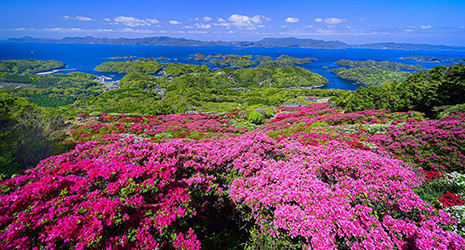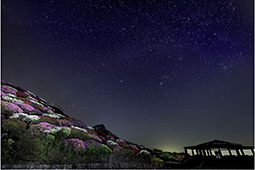April 2022
- English
- 日本語
A Carpet of Azaleas Overlooking the Sea

Azaleas at Nagushiyama Park in Sasebo City, Nagasaki Prefecture 
Evening view of Kita-kujukushima from the observatory at the summit

Night sky and azaleas on Mt. Nagushiyama 
View over Sasebo City toward Kujukushima from the observatory located at the summit of Mt. Ishidake (shooting location for the opening scene of the Hollywood movie The Last Samurai)

Nagushiyama Park in northwestern Kyushu, the most southerly of Japan’s four main islands, is spectacular in springtime for its carpet of azalea flowers overlooking the sea.

Tsutsuji (azaleas), with their red, pink or white blooms from April to June, have long been selectively cultivated in Japan for horticultural use, including as garden plants. Azaleas are in fact one of the most familiar plants in Japan, being commonly planted along streets and in parks. There are many celebrated viewing spots for azaleas throughout Japan, but among these Nagushiyama Park in Sasebo City, Nagasaki Prefecture, is renowned for its magnificent view of the sea behind a carpet of blooming flowers.
Nagushiyama Park is located in the area around the summit of the 234-meter-high Mt. Nagushiyama in Sasebo City, Nagasaki Prefecture. Local people have been planting azaleas here since 1969. On the southern slope of the park overlooking the sea, around 100,000 kurumetsutsuji and hiradotsutsuji azalea, endemic species of Japan, bloom in reds and pinks from mid-April to early May, creating a landscape that seems to be decorated with a carpet of flowers.
“The view of the azaleas looking up the mountain side from the observation deck halfway up the slope is awe-inspiring, while the view in the opposite direction is of a sea dotted with islands. The contrast between the two is extremely dynamic,” says a member of staff at the Nagushiyama Visitor Center.

The surrounding coastline, including Nagushiyama Park, is officially designated as the Saikai National Park, also known as the “kingdom of islands.” Looking east from the park, one can see the rias coastline (an intricately complex or “sawtooth” coastline) and the many islands known collectively as Kujukushima below, with the strikingly large island of Hirado, which gives its name to the hiradotsutsuji azalea variety, on the opposite shore. Kujukushima comprises 208 islands, from small to large, and the panoramic view from Nagushiyama Park takes in 110 of those islands, situated mostly in the northern half of Kujukushima and known collectively as Kita-kujukushima*.
“If you want to enjoy the view of azaleas together with the Kita-kujukushima islands in the sea, we recommend the observation deck at the summit. The spectacle of the sun setting over Hirado Island in particular is breathtakingly beautiful, and many people take photos of it,” says the Visitor Center staff member. Red azalea means “the joy of love” in the language of flowers, and it seems it’s a popular spot for lovers.
Sasebo City is the location of Mt. Ishidake (191 meters above sea level), where the opening scene of the Hollywood movie The Last Samurai was filmed. The port city is full of appeal, offering specialties such as Sasebo burgers and lemon steaks, as well as a wide range of local seafood and other dishes. In spring, that appeal is magnified by the vivid colors of the azalea blossoms.

* The Kujukushima islands that extend from Shikamachi Town, where Mt. Nagushiyama is located in Sasebo City, to Kosasa Town in Sasebo City, are called Kita-kujukushima.

